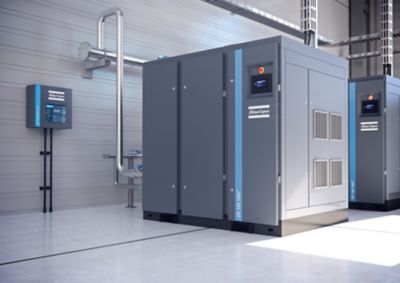With a gas turbine and steam turbine, a thermal combined cycle power plant transforms thermal and natural gas energy into electricity. With this, the natural gas mixture consists of primarly of methane (75-95%).
These types of power plants are up to 56% more efficient and produce less CO2 than typical gas combustion thermal power plants. This is because leftover energy from the gases can be used for additional cycles. Also, compared to other thermal power plants, 35% less cooling water is consumed.
Now that we've covered the basics of combined cycle thermal power plants, we'll dive further in the rest of the article. Read on to learn more about the following:
● The combined cycle gas turbine plant
● Use of nitrogen generators in a thermal combined cycle power plant
● The right nitrogen for a CCGT plant
The combined cycle gas turbine plant
The most common type of combined cycle power plants are thermodynamic, introduced above. They are also referred to as combined cycle gas turbine (CCGT) plants, and are gas-fired. The overall concept is that the exhaust from one engine can be used for a second engine. This is made possible with a heat exchanger.
As CCGT plants become increasingly more popular to meet demands, they are switched on and off more frequently. As a result, these types of power plants require more nitrogen. This is because nitrogen is essential for inerting combustion systems, offload preservation, among other uses.
Use of a nitrogen generators in a thermal combined cycle power plant
To reiterate, one of the main uses of nitrogen in a CCGT plant is inerting the combustion systems. This is because the presence of air and gas in combustion rings would lead to an explosion risk. Therefore, reducing the concentration of oxygen with nitrogen is crucial. For this purpose, high pressure nitrogen (approximately 50 bar) is used.
To achieve such pressure levels, you’ll want a nitrogen booster, storage tanks, and regulator. With this equipment, you can store high pressure nitrogen and use it at the desired pressure level. As a result, an effective inertization of the combustion system at a very high speed is possible.
A second important area where nitrogen is used is in the steam recovery boilers. During the inactivity time of the plant, it is essential to keep the boilers inert with low pressure nitrogen. This avoids corrosion of the steam drums and keeps them in perfect condition. Another term for this is offload preservation.
The right nitrogen for a CCGT plant
The necessary nitrogen flow depends on the size and leak rates of the boiler, as well as application. To inert combustion systems, you’ll need 50 bar pressure. With steam recovery boilers, low pressure N2 is required. As you can see, it’s important to have a system capable of multiple pressure levels. We’re able to design an optimal setup to meet such demands.
In addition, you’ll want to pay attention to the purity of the nitrogen. This is determined by the flammability characteristics of the fuel. In the case of natural gas, this is methane, as previously stated.
Methane has a 8.6% minimum oxygen concentration (MOC). Below this MOC, a flammable mixture will not form. Normally, the minimum safety factor considered in terms of allowable oxygen concentration is MOC/2, which would lead to a nitrogen purity of 93%. With a CCGT plant, a nitrogen purity of 97% is commonly used.
On-site nitrogen generators, along with boosters and storage can deliver both high purity nitrogen and adequate pressure levels. This equipment saves money on deliveries and provides on-demand N2 whenever it’s needed. If you'd like more information about this or anything else covered in this article, feel free to reach out today. Our team is happy to help.


